
About Bhutan
Tourism in Bhutan
The tourism industry in Bhutan is one of the major service industries contributing to national foreign exchange and creating employment opportunities. Ever since the start of tourism industry in 1974, Bhutanese Government has recognized the valuable benefits and is also aware of negative impact on environment. Therefore, the policy of the country has been framed in such a way to promote Bhutan as a sustainable tourism destination in the world. So far, the number of tourists to the country has been regulated by the minimum daily tariff (US$ 250 for the high season and US$ 200 for the low season).
Tourism in Bhutan functions unlike in rest of the world. It is strictly regulated and monitored by the Tourism Council of Bhutan (TCB), an autonomous agency under the government of Bhutan. They set rate, regulate and monitor hotels standards, guides, and other tourism products.
What is Minimum Daily Tariff?
For all tourists besides Indian, Bangladeshis and Maldivian nationals, you are required to pay the tour package cost as minimum daily tariff to royal government of Bhutan. Tourist guest are to be one Guided Tour. You cannot go on a free and easy tour in Bhutan as Government has controlled tourism in order to preserve their nature and cultural heritage.
Thus there is implementation of Minimum Daily Tariff. Minimum Daily Tariff is broken into two season in Bhutan high season (March, April May | September, October & November) and low season (June, July & August | December, January & February). The Royal Government of Bhutan sets minimum selling prices for packages to Bhutan. These must be paid in US dollars prior to arrival in Bhutan.
The system of a daily minimum tariff has been set as USD 250 per person per night for high season in Bhutan and USD 200 for low/off season. The price also in a way limits the volume of visitors allowing exclusivity and care.
The daily minimum price is most often misinterpreted to be extremely high. The fee in fact covers a package that include all internal taxes and charges including royalty, accommodation, all meals, services of licensed guides, internal transport and camping equipment and haulage for trekking tours.
The royalty portion goes to the government exchequer, which in turn mainly support free medical care, free education and other welfare schemes. All visitors in way therefore make valuable contribution to the welfare system of the country.
The International Tourist Tariff is set by the Royal Government of Bhutan and is valid for all-
inclusive package. The tariffs for tourists visiting in a group of 3 persons or more are as follow:
High Season Tariff
For ( March, April, May, September, October and November) US$ 250 per person per night
Low Season Tariff
For (June, July, August, December, January and February) US$ 200 per person per night
Both the above rates are applicable for cultural tours, treks or any other special interest tours.
Surcharge
Individual tourists and smaller groups of less than three persons shall be subject to surcharge, over and above the minimum daily rates applicable, as follows:
Single individual US$ 40 per night
Group of 2 persons US$ 30 per person per night
Single Room supplementary US$ 45 per night.
Single Tent supplementary US$ 40 per night.
說明 Introduction
Places to Visit when in Bhutan
Places such as Thimphu, Paro, Phuentsholing, Bumthang, Mongar, Lhuntse, Phobjikha, Gangtey, Haa, and Punakha are known for gorgeous natural beauty, monasteries, nunneries and great mountain valleys. Here are places you must explore when in Bhutan.
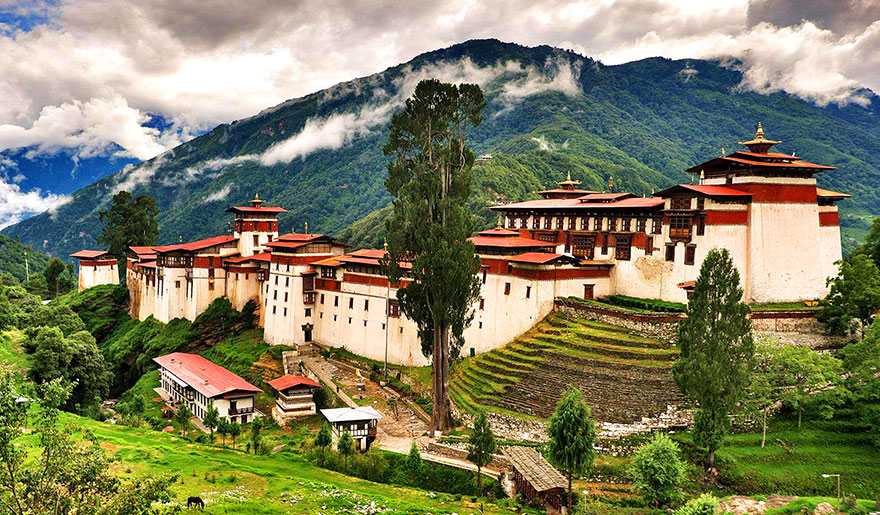
Thimphu
Thimphu, one of the culturally must see places in Bhutan, is charming capital city nestled in the Himalayas with the beautiful sights of the Chuu River flowing through it. Interestingly, it is the only city in the world with no traffic lights. Thimphu has retained its culture and old world charm as modern development is closely monitored and new buildings can be built only in Bhutanese style and up to a certain height.
Places of interest in Thimphu
Tashichhodzong: Also known as the "Fortress of the Glorious Religion". It was built in 1641. The Dzong was latter rebuilt by the third king, His Majesty Jigme Dorji Wangchuk in 1965. Known as the ‘fortress of glorious religion’, the Tashicho Dzhong was originally built in 1641. It was rebuilt in 1952 by the third king and is now used as the seat of the Royal Bhutanes e Government. Situated in beautiful gardens, it is also the summer residence of the central monastic body.
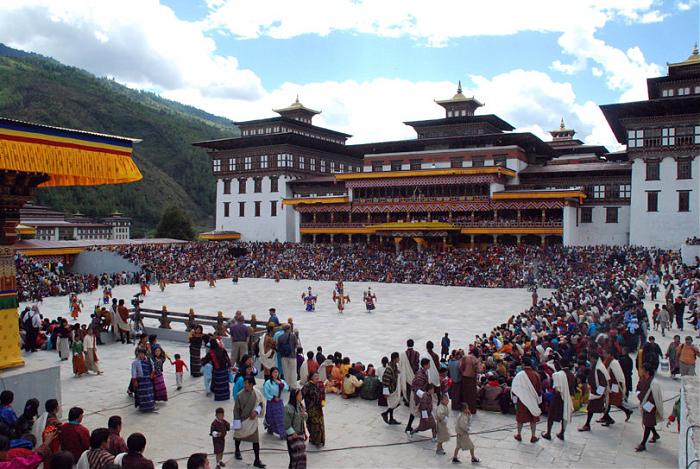
The National Textile Museum - This museum displays a range of beautiful Bhutanese textiles. It was started in 2001, under the patronage of Her Majesty the Queen, Ashi Sangay Choden Wangchuk. It is a national textiles museum in Thimphu, Bhutan, located near the National Library of Bhutan. It is operated by the National Commission for Cultural Affairs. Since its establishment in 2001, the museum has generated national and international attention and has garnered a substantial collection of antique textile artifacts, exclusive to Bhutan. The objective of setting up the museum is to promote Bhutan's achievements in the field of textile arts and to sustain and promote interest of the weavers to continue the traditional textile patterns. The museum also envisions becoming the centre for textile studies and research. The purpose is also to promote the history and culture of Bhutan.
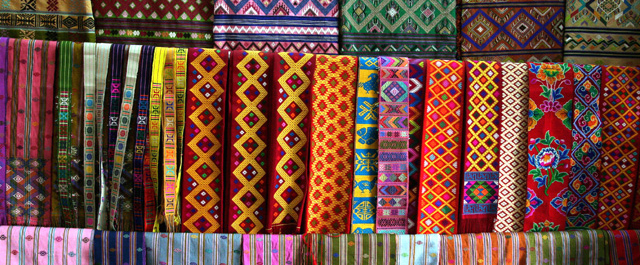
The Folk Heritage Museum - It is also known as Phelchey Toenkhim, It provides a fascinating insight into the traditional Bhutanese farm house and rural past through exhibits anddocumentation of rural life. Located in the capital city of Thimphu, this museum was established in 2001 and provides visitors and tourists with fascinating insights into the Bhutanese material culture and way of life. The Folk Heritage Museum is set inside a three storied, 19th century traditional house. The museum gives you a glimpse of the traditional Bhutanese lifestyle, in addition to artifacts from rural households; it also displays an impressive collection of typical household objects, tools and equipment. The museum also organizes regular demonstrations of rural traditions, skills, habits and customs as well as hosting educational programs for children.In an effort to maintain our knowledge of indigenous natural resources, native trees and plants that had domestic uses in a rural Bhutanese household is grown, creating an oasis of greenery, right in the heart of the capital city of Thimphu.
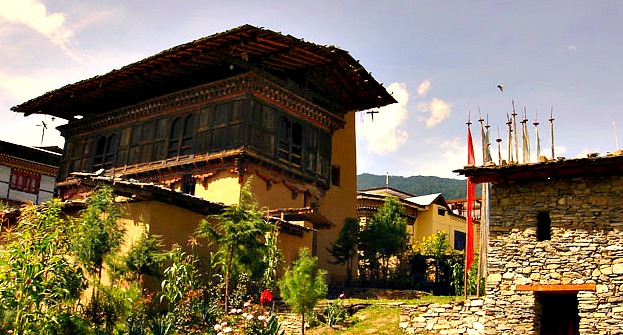
The National Institute for Zorig Chusum - Is also known as the School of Arts and Crafts. It is an institute where students undertake a six-year course on the 13 traditional arts and crafts of Bhutan. This institute, commonly known as 'the painting school', operates four- to six-year courses that provide instruction in Bhutan's 13 traditional arts. Students specialise in painting (furniture, thangka s – painted religious pictures, usually on canvas), woodcarving (masks, statues, bowls), embroidery (hangings, boots, clothes) or statue-making (clay). The Institute of Traditional Medicine Services - Here Bhutan's famous traditional medicine are compounded and dispensed. The Institute is based in Thimphu, the capital of Bhutan, located on a hilltop above the Traditional Arts Center and the National Library. The Institute supplies traditional medicines and medical services, trains doctors, and conducts research on traditional medicinal plants to identify the ingredients and develop new products. The Institute has a library dating back to around 1616, when Tibetan Buddhism was introduced to Bhutan. The books and recipes were collected from monasteries where scholars had preserved the medical lore.
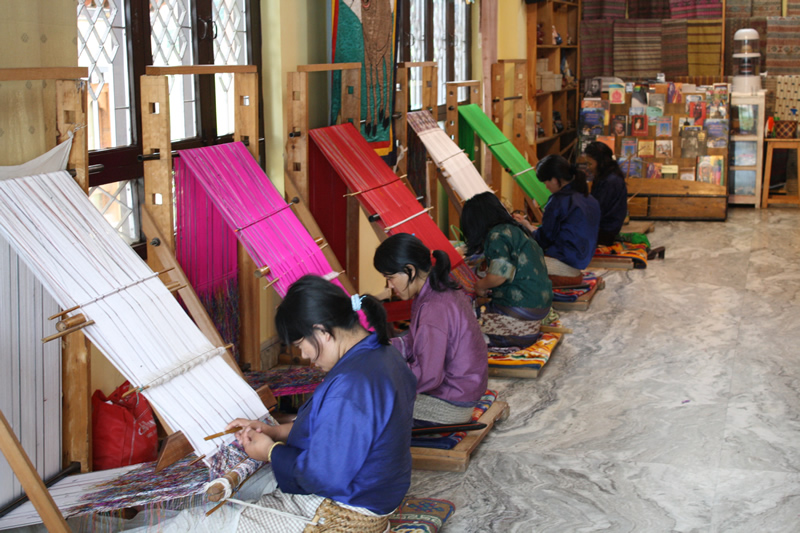
Takin Preserve - Here you will find the rare national animal of Bhutan. The best time to see them is early morning. The Takin is listed by international conservation agencies as a animal found only in Bhutan, Nepal, Burma and China. Motithang Takin Preserve, located in the Motithang district of Thimphu, Bhutan is a wildlife reserve area for takin, the national animal of Bhutan. Originally a mini-zoo, it was converted into a preserve when it was discovered that the animals refrained from inhabiting the surrounding forest even when setfree. The reason for declaring takin as a national animal of Bhutan on 25 November 2005 (Budorcas taxicolor) is attributed to a legend of the animal’s creation in Bhutan in the 15th century by Lama Drukpa Kunley
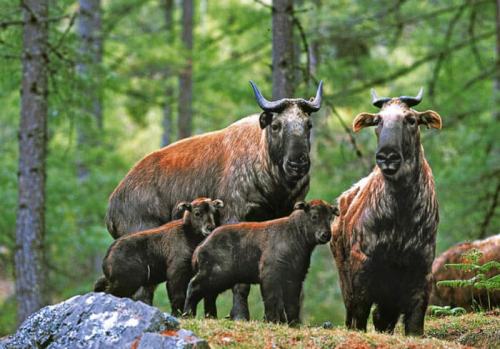
The National Library - This library holds a vast collection of Bhuddhist texts and manuscripts, some dating back several hundred years, as well as modern academic books mainly on Himalayan culture and religion.
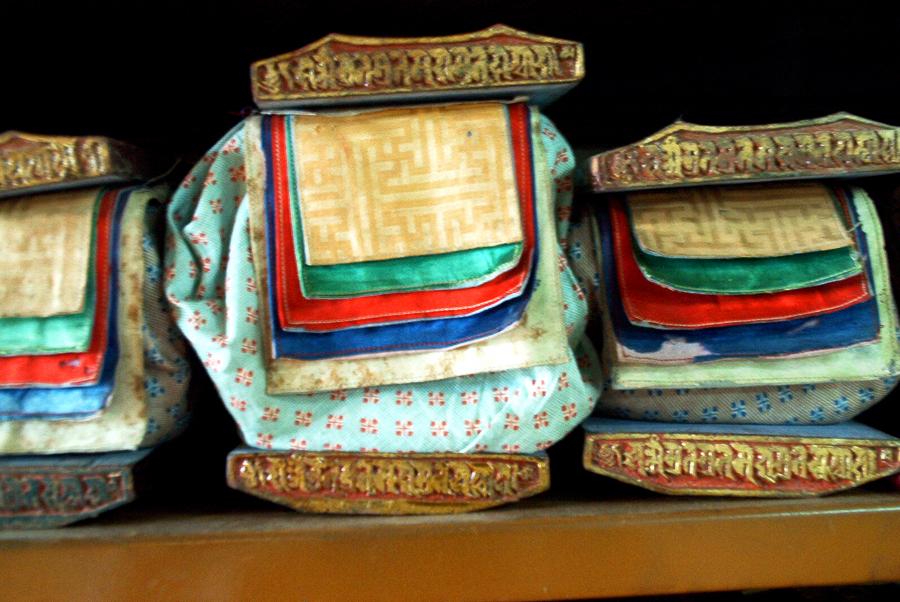
Dechenphodrang - This is a monastic school with more than 450 monks currently undergoing their studies. At the end of Gaden Lam is Dechen Phodrang, the site of Thimphu's original 12th-century dzong. Since 1971 it has housed the state monastic school, providing an eight-year course to more than 450 students. The 12th-century paintings in the goemba's Guru Lhakhang have been restored, and the upper floor features a large figure of Zhabdrung Ngawang Namgyal as well as a goenkhang (chapel dedicated to protective deities).
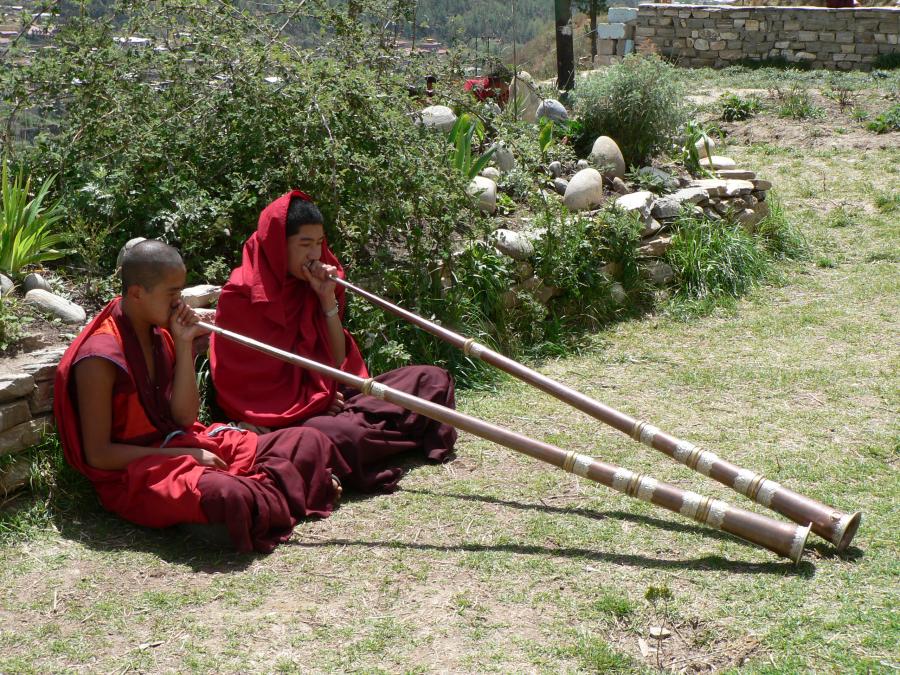
Changangkha Lhakhang - This is an old fortress-like temple perched on a ridge above Thimphu. The temple was built in 12th century by Lama Phajo Drugom Shigpo's son Nyima. This popular fortress-like temple perched on a ridge above central Thimphu regularly hums with pilgrim activity. It was established in the 12th century on a site chosen by Lama Phajo Drukgom Shigpo, who came from Ralung in Tibet. Parents traditionally come here to get auspicious names for their newborns or blessings for their young children from the protector deity Tamdrin (to the left in the grilled inner sanctum, next to Chenresig). Don't leave without taking i he excellent view from the back kora (pilgrim path), with its lovely black and gold prayer wheels.
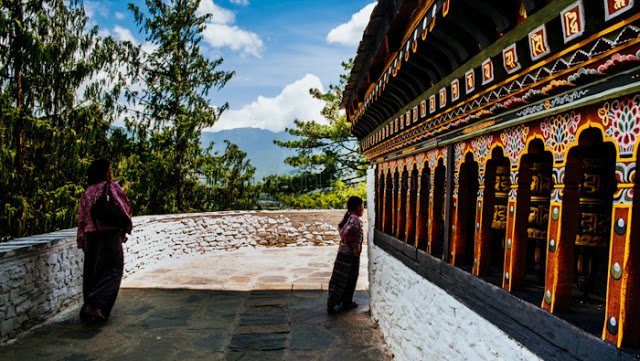
Zangto Pelri Lhakhang - This is a private temple built in 1990s by Late Dasho Aku Tongmi, a musician who composed Bhutan's national anthem. Semtokha Dzong - It stands on a lofty ridge five miles from Thimphu town was built in 1627 by Zhabdrung Ngawang Namgyal. Legend has it that the site was inhabited by demons therefore Zhabdrung subdued one particular demon and enclosed it in a rock. The dzong was built over this stone thus deriving the name sinmo (demon), do (stomach), and kha (on) – the dzong on top of the demon’s stomach. It was built in 1629.
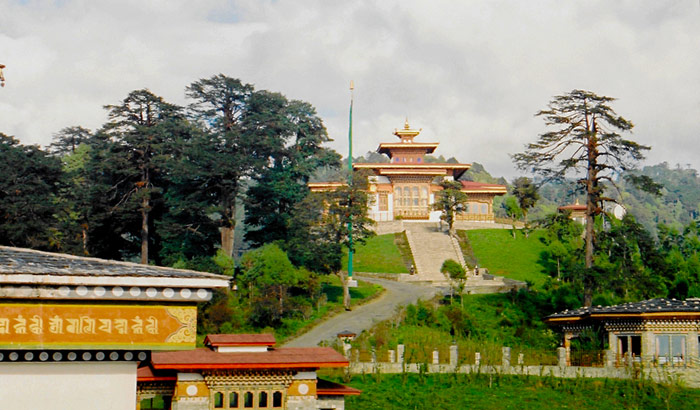
Phajoding Goenpa - It is a three hours walk from upper Thimphu. The monastery was built in the 15th century by Shagcha Rinchen who introduced the Drukpa Kagyu School in Bhutan in the 13th century.
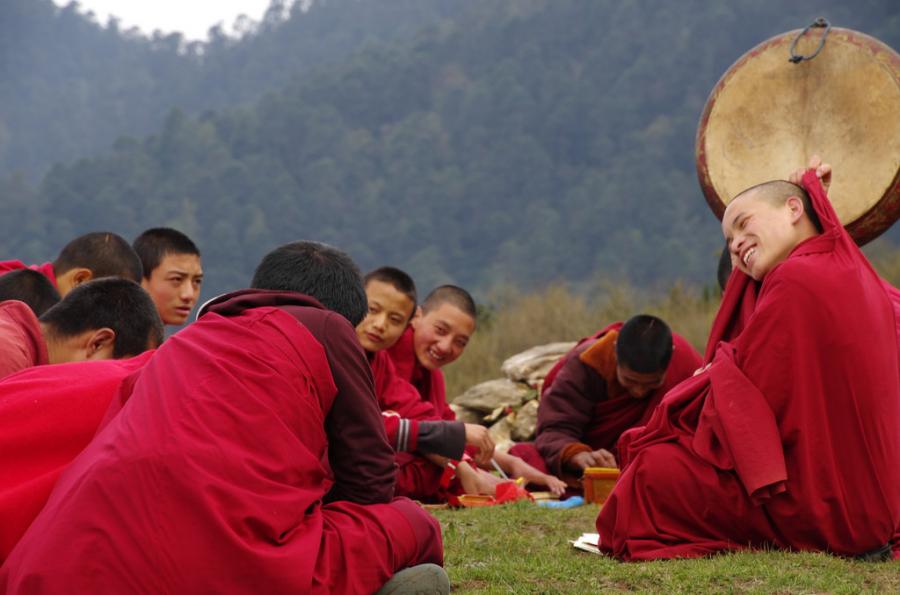
Tango Goenpa - It is a half hour drive from Thimphu town and an hour walk to the monastery.
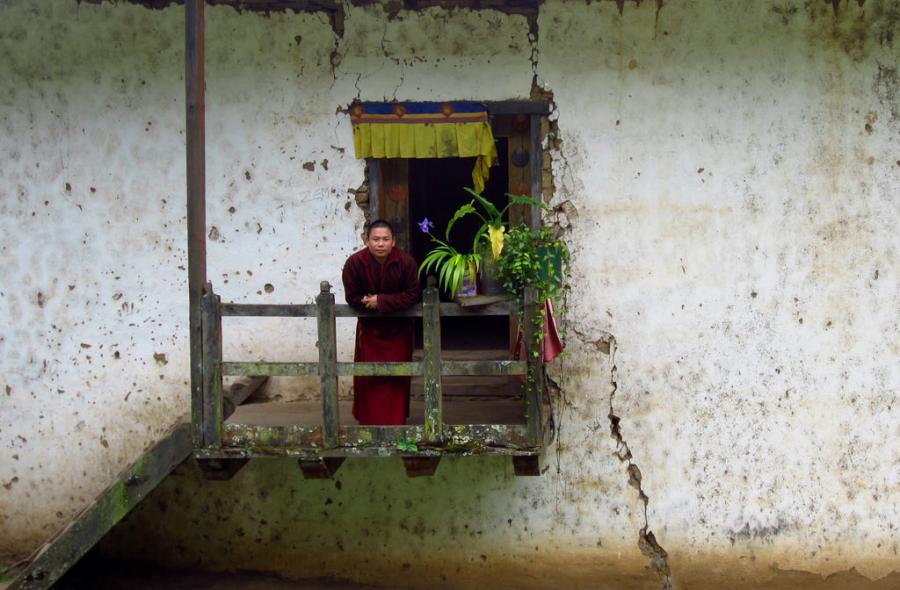
Cheri Goenpa - It is a half hour drive from Thimphu town and an hour walk to the monastery. The trail starts from a quaint bridge that spans the Thimphu Chhu Memorial Chorten, Thimphu Landmark The Memorial Stupa, Thimphu, also known as the Thimphu Chorten, is a stupa in Thimphu, Bhutan, located on Doeboom Lam in the southern-central part of the city near the main roundabout and Indian military hospital.
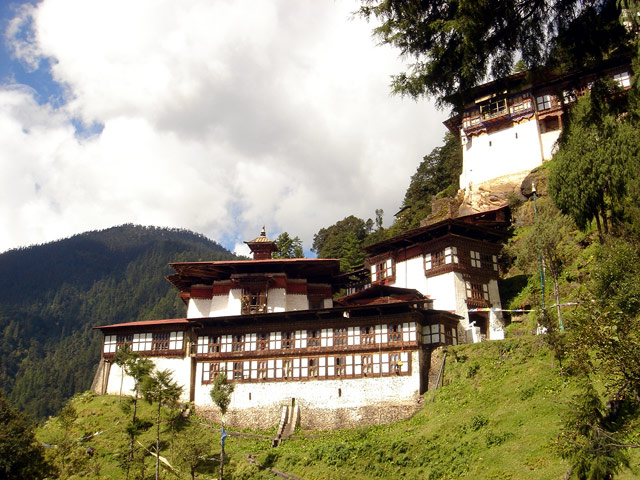
Buddha Dordenma is a gigantic Shakyamuni Buddha statue. It is 6 km drive from Thimphu Town. The statue is a major pilgrimage centre and a focal point for Buddhists all over the world to converge, practice, meditate and retreat. It is also meant to fulfill the prophecy of bestowing blessings, universal peace and happiness to the world. The Buddha statue overlooks the capital city within the gigantic bronze structure. The rooms from the third storey till the top will accommodate 100,000 statues of eight-inch Buddha Dordenma made of copper and gilded in gold placed in multi-layered grid-boxes. It is one of the largest Buddha statue in the world with the height of 169 feet (51.5 meters).
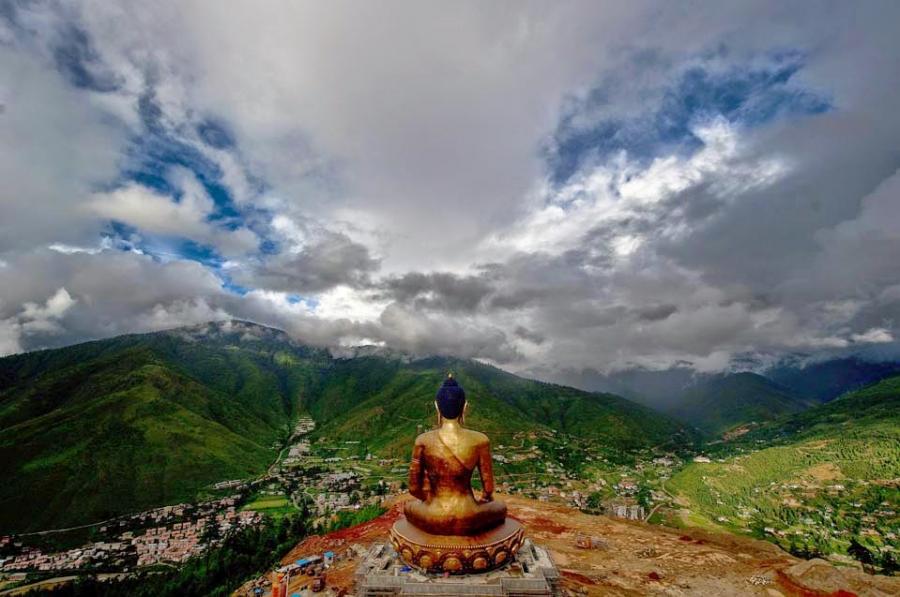
Places to see in Paro
Paro, the foremost must see place in Bhutan, is a gorgeous beautiful valley, surrounded by lush green rice fields. Paro is a historic town with many sacred sites and historical buildings scattered through the area. Along with Jakar and Punakha, Paro forms the ‘golden triangle’ of popular tourist destinations in Bhutan. Likewise, craggy mountain hills and undisturbed serene beauty, the clean air and peaceful atmosphere make it a must visit place in Bhutan. In Paro, Rinpung Dzong mostly attracts the visitor. Rinpung Dzong is one of the finest examples of a Bhutanese monastery. The Dzong hosts the Paro Tsechu i.e festival of masks. Beyond this, National Museum of Paro holds the visitors in Paro. The museum exhibits rich stamp collections, slate carvings, Thangka paintings, prehistoric items, jewellery, traditional weapons and other articles reflecting Bhutanese culture.
Paro Taktsang is the popular name of Taktsang Palphug Monastery, a prominent Himalayan Buddhist sacred site and temple complex, located in the cliffside of the upper Paro valley, in Bhutan. Taktsang Monastery also recognized as Tiger’s Nest in Paro is one of the holiest places in Bhutan. The monastery is mounted on a high granite cliff and was established for meditation. The monastery is perched on a rocky ledge with a sheer drop of nearly 800m, and overlooks the Paro valley and the river.It is also an ideal place for a short trek.
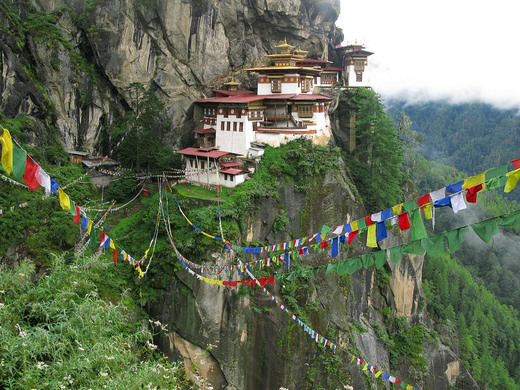
Rinpung Dzong is a large dzong - Buddhist monastery and fortress - of the Drukpa Lineage of the Kagyu school in Paro District, Bhutan. It houses the district Monastic Body and government administrative offices of Paro Dzongkhag.
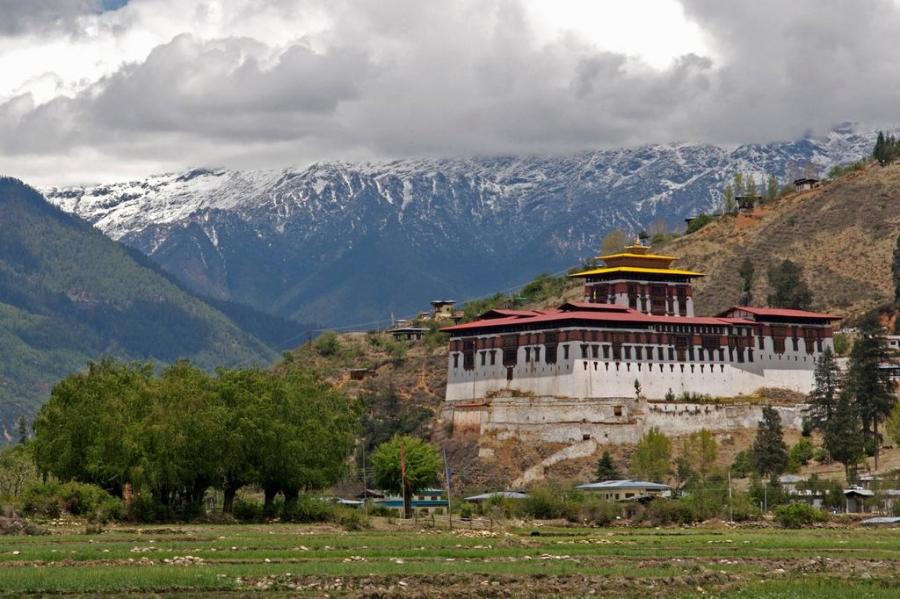
Drukgyal Dzong was a fortress and Buddhist monastery, now in ruins, located in the upper partof the Paro District, Bhutan.
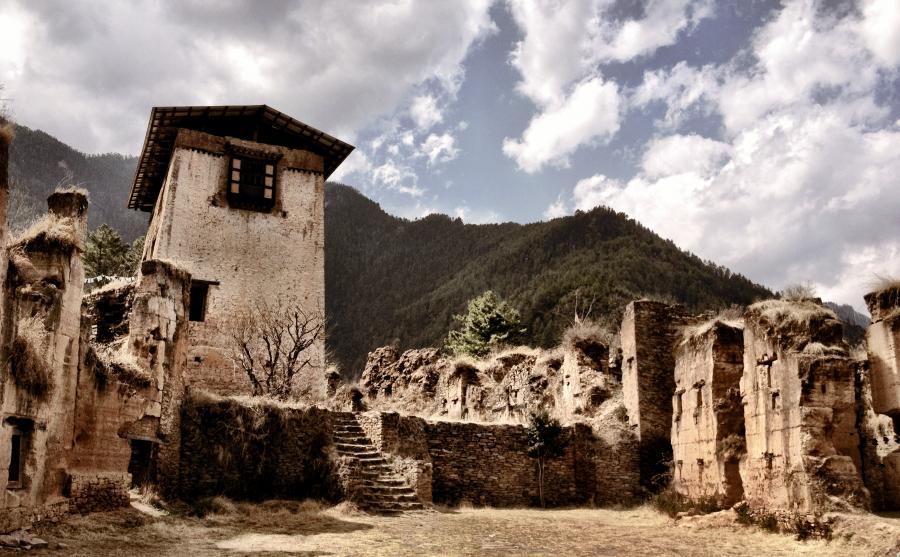
National Museum of Bhutan is a cultural museum in the town of Paro in western Bhutan. Established in 1968, in the renovated ancient Ta-dzong building, above Rinpung Dzong under the command of His Majesty.
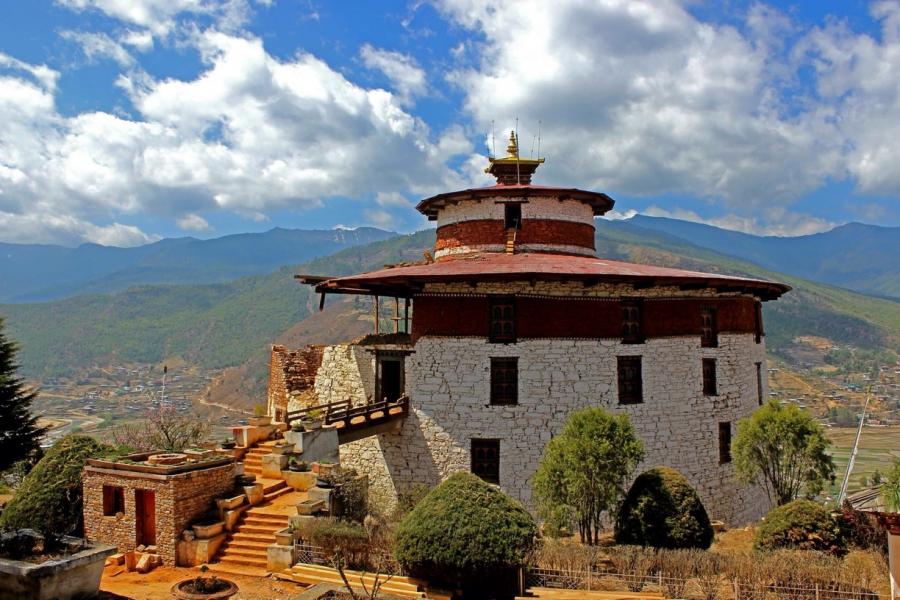
Wangduephodrang, another popular place in Bhutan, is the last town on the central highway before central Bhutan. Located in the south of Punakha, the higher reaches of the Wangduephodrang valley provide rich pastureland for cattle. This district is also famous for its fine bamboo products, slate and stone carvings. Wangduephodrang Dzong, sitting on top of the hill at the confluence of Punakha Chhu and Tang Chhu rivers, is the attractive landmark of Wangduephodrang. The Dzong is open for visitors during Wangduephodrang Tsechu celebration in autumn.
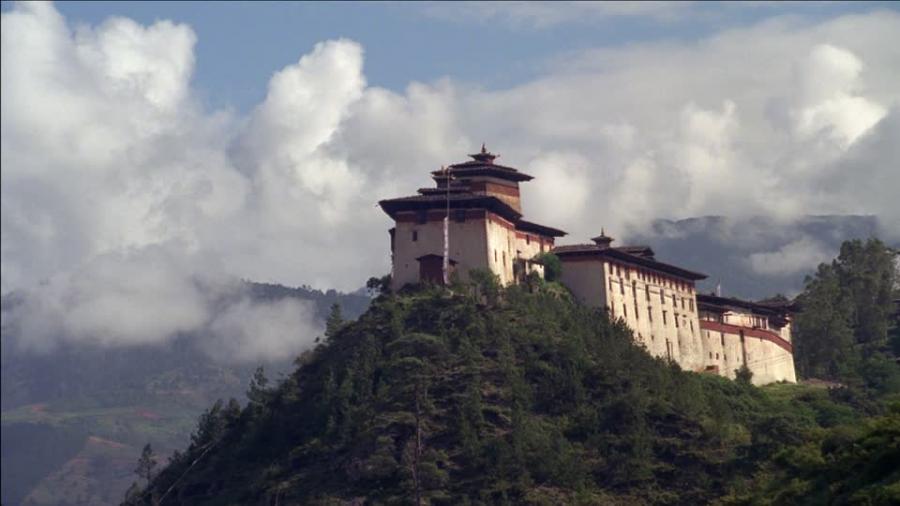
The Gangteng Monastery,generally known as Gangtey Gonpa or Gangtey Monastery, is an important monastery of Nyingmapa school of Buddhism, the main seat of the Pema Lingpa tradition. located in the Wangdue Phodrang District in central Bhutan.
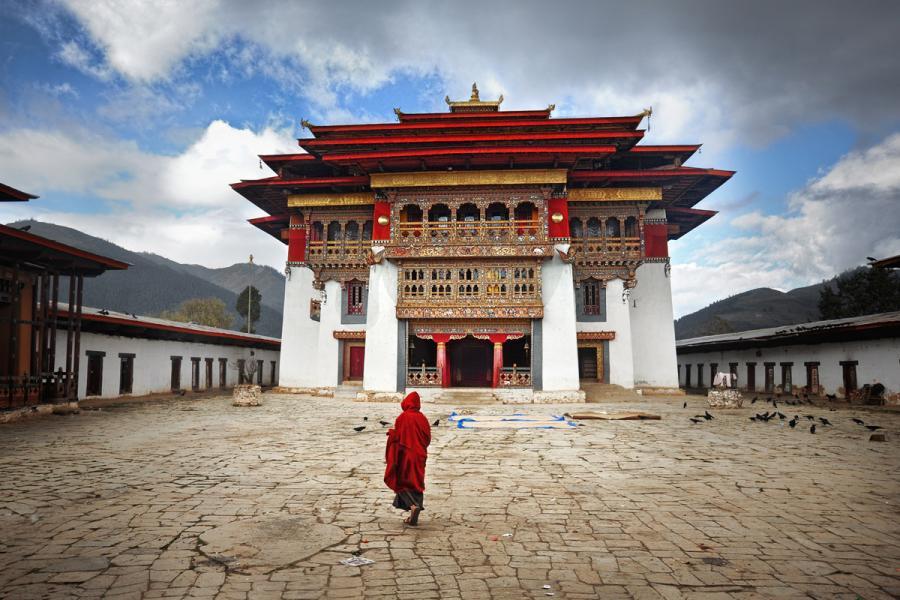
Bumthang Valley, the spiritual heartland of Bhutan, is full of most ancient and precious Buddhist sites. Located at an altitude of 2,600 meters, the religious hub of Bhutan houses some of the oldest Buddhist temples. Besides, Jakar is the main town in Bumthang Valley and its undulating terrain, which is filled with apple trees and numerous temples, is a tourist’s delight.
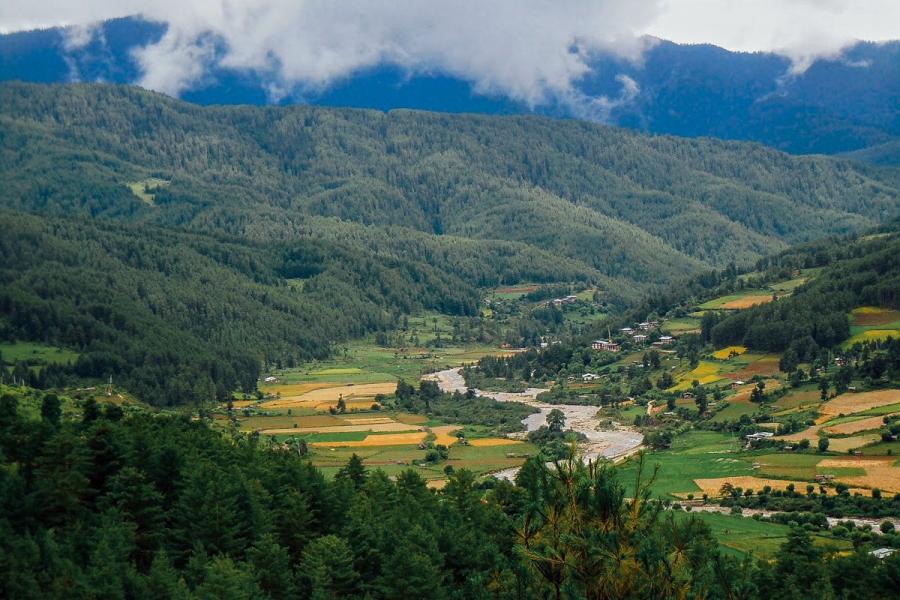
The Phobjikha Valley is a vast U-shaped glacial valley, also known as Gangteng Valley named after the impressive Gangteng Monastery of the Nyingma sect in central Bhutan, where the graceful black-necked cranes in Bhutan from the Tibetan Phobjikha and Gangtey Valley, both the places are also must see locations in Bhutan. The Gangtey and Phobjikha are glacial valleys with a stream flowing through their open grasslands presenting one of the most beautiful landscapes in Bhutan. It is home to endangered black necked crane. The famous Black mountain national park, home to diverse specie of flora and fauna is also nearby. It is around 6 hours drive from Thimpu. The drive among Dochula Chortens and Rhodos is mind-blowing. The entire region is sometimes called Gangtey. Gangtey Monastery and Jigme Singye National Park are famous among visitors in the region.
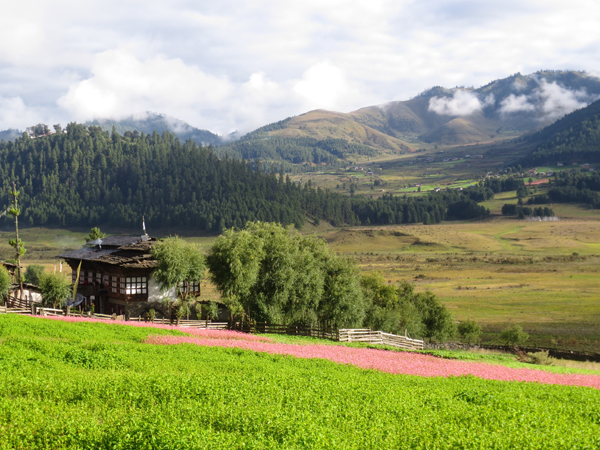
Punakha Dzong - Being the second oldest and second largest dzong in Bhutan, Punakha Dzong, or some call it Pungthang Dewachen Phodrang (Palace of Great Happiness), is also the country’s most gorgeous and majestic dzong. Punakha is accessible from a 3 hours drive east of the capital Thimpu, and after crossing a pass in the mountains, the place is a breathtaking and glorious sight on the first glimpse from the road. It is placed strategically in between two rivers, Pho Chu (male) and Mo Chu (females) that has noticeable color differences between the rivers’ water. Punakha Dzong joined to the mainland by an arched wooden bridge and contains many precious relics from the days when successive kings reigned the kingdom over this valley. Furthermore, it is blessed with a temperate climate, and lovely lilac colored acaranda trees grow around the dzong during the spring season.
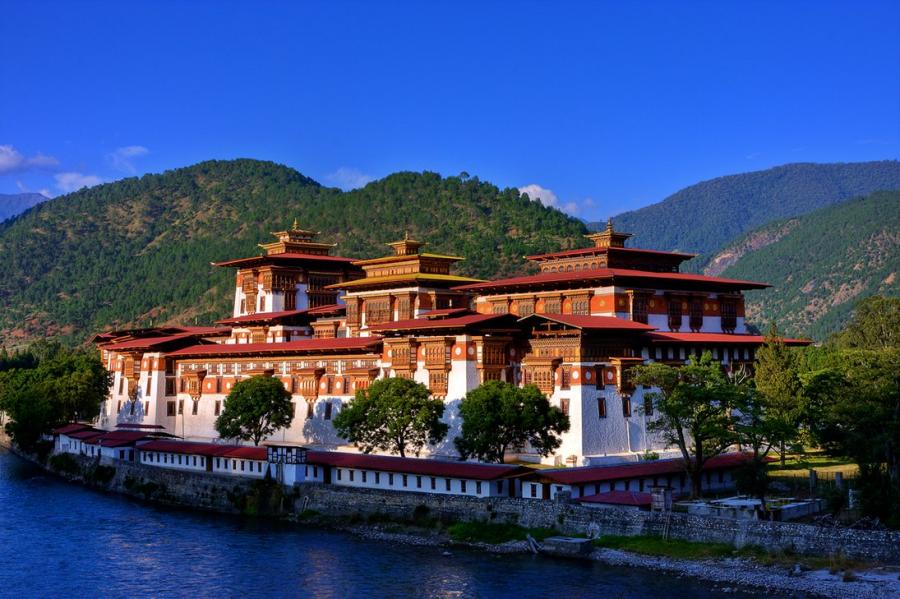
Tiger’s Nest Monastery - The Tiger’s Nest Monastery hangs on a cliff and stands above an enchanting forest of blue pines and rhododendrons. As this beautiful and very exceptional monastery is a sheer climb the hill (900 meters), a pony can be arranged for the ride up, but only until the cafeteria. From then on, it is another steep walk and some narrow stairs towards the monastery itself. The trail crosses a chapel of butter lamps and descends to a waterfall by the Snow Lion Cave. The view of the Paro valley from here on is breathtaking, and the atmosphere very holy, a place where every Bhutanese will want to come at least once in his/her life. The place where Guru Rinpoche brought Buddhism into Bhutan, arriving on the back of a tigress.
The valley of Gangtey is one of the most stunning valleys in the Himalayas, and many call it the Shangri-La of Bhutan, just as how Bhutan is well known for being “one of the world’s happiest nations,” and “the last Shangri-La on Earth.” The surprise of finding such a wide, flat valley without any trees after the hard climb through dense forests is augmented by an impression of vast space, which is an extremely rare experience in Bhutan as most of the valleys are tightly enclosed. This moderate trek visits the villages of Gogona and Khotokha, passing through meadows and fields, then forests of juniper, magnolia and hododendrons, which will be in full bloom in April. Besides the attractive scenic valley and mountain trails passing through the magnificent forest with its undergrowth changing from rhododendron and magnolia to ferns and dwarf bamboo, we can also visit the historical Gangtey monastery and the blacked necked crane information centre. Additionally, there will be a special treat for those visiting the Gangtey during the winter season, as they will be able to catch the graceful Black - necked Cranes in action as they head to the roost.
THIMPU
In Thimpu, the capital of Bhutan, visit its colourful weekend market and quirky shops, museums and landmarks like the National Memorial Chorten, built by the third king His Majesty Jigme Dorji Wangchuck. This small city was established as the capital in 1961 and is famous for being the only capital in the world without traffic lights!
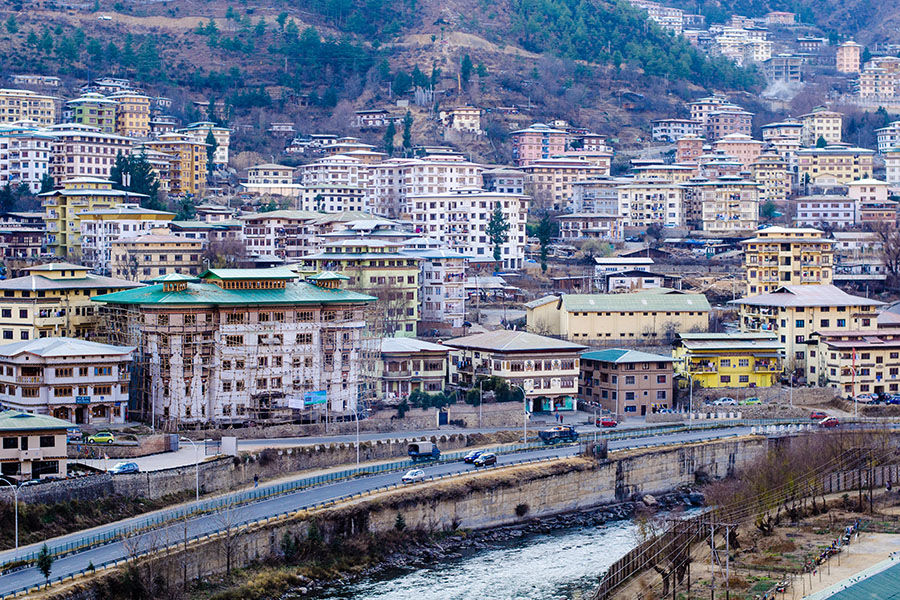
Itinerary
注意事項 Notes
About Trekking in Bhutan
Trekking in land of Happiness, also known as Land of the Thunder Dragon” or “last Shangri-la”, a landlocked country situated in South Asia at the eastern end of the Himalayas. Bhutan stand on a mountain pass on the world’s highest range, snow flecked all around and prayer flags flapping like a grateful audience. Bhutan has a rugged and mountainous landscape with snowcapped peaks and glacier covered terrain in the north, spurs of the Himalayan peaks in the center and heavily forested foothills and subtropical plains in the south.
Bhutan is bordered to the north by China and to the south, east and west by India. To the west, it is separated from Nepal by the Indian state of Sikkim, while farther south it is separated from Bangladesh by the Indian states of Assam and West Bengal.
With its rugged mountains on the Himalayan peaks it make an impressive trekking trail for any trekking enthusiast.
Trekking holidays in Bhutan have been developed to offer unlimited opportunities to enjoy the unique cultural heritage of Bhutan as well as the stunning mountain vistas and untouched wilderness regions of Bhutan. Whether you are looking for a day hike or a grueling 31 day adventure, we have it all. Pristine mountain lakes, imposing glaciers and some of the world’s most endangered species await you in the mountainous amphitheater of the Himalayas.
Note: Trekking routes provided are general guides only and may have inaccuracies. They are not to be used for navigation. Your trek guide is the expert on the route to take.
Quick Info about Bhutan Trekking
Best season: Spring & Autumn, Bhutan is best place for true Trekking lover, trekker must be mentally prepared and physically fit to face the unexpected expeditions and abrupt changes in elevation. Treks can be long or short with daily 07-19 kilometers walk to reach the campsites. Bhutan has identified number of trekking routes that render opportunity to experience the cultural, incredible scenic beauty, Entire Himalaya’s ranges, yak herders, flora and fauna and so, it will be always most challenging and memorable experience.
Treks cost Include: Government Licensed Trekking Guides, who are trained to deal with Acute Mountain Sickness (AMS), trekking cook, assistants, horsemen, provided three times meals, mattresses (we can provide on minimum charges per day), two men sleeping tents, dining tents, kitchen tents, toilet tents and utensils. Heavier stuff will be carried by horses or yaks but your camera, water bottle and your side bag you only have to carry. Campsite will be always designated at a place where there will water supply to cook your meals and meadows to feed your ponies.
Need to bring for Treks: Sleeping bags, water proof trekking bag, Strong comfortable trekking shoes, pants, Socks (woolen), cotton T-shirts, Woolen hat, Waterproof jacket, Umbrella, Water bottle, Torch (flashlight, batteries), Pocket knife (be sure this is packed in your checked baggage to avoid hassles with airport security), Sun block (SPF 15-plus), Towel, Laundry soap, Slippers, Insect repellents, Medical & first aid kit, Water purifier tablets, please bring Extra warm cloths, during long trekking you obviously have to change and wash your cloths and etc. There is no trekking store here in Bhutan to buy or rent one and we suggest you to buy this from your place. The trekking cost does not include your insurance.
We can provide following Trekking in Bhutan:
1. Bumtang Cultural Trek
2. Cheli La Nature Trek
3. Dagala Thousand Lakes Trek
4. Druk-Path Trek
5. Dur Hot Spring Trek
6. Gangtey – Gogona trek
7. Gasa Hot Spring Trek
8. Jhomolhari Basedcamp Trek
9. Jhomolhari Round Trek
10. Laya Gasa Trek
11. Punakha Winter Trek
12. Samtengang Trek
13. Snowman Trek
Note: Detailed Itinerary for the trekking can be provided accordingly to your request, also we can customize the trekking itinerary based on your requirement. So please do not hesitate to ask us your query.
Bhutan is swiftly developing its reputation as a premier destination for adventure sports. Set amongst the majestic Himalayas our kingdom is the perfect location for all manner of exciting activities including Hiking, Trekking, Kayaking, Mountain Biking and Fishing.
Whether it’s rafting down crystal clear, glacier-fed rivers or trekking through lush, virgin forests Bhutan offers a one-of-a-kind experience for travelers seeking adventure in an unspoiled and unexplored environment.
All the necessary arrangements for adventure activities can be made through your local tour operator. They will provide you with well-trained and experienced guides to ensure your safety at all times. The adventures tours introduced were
- Cycling Tour in Bhutan
- Kayaking and River Rafting tour
- Rock Climbing
- Fishing Tours
- Trekking in Bhutan
- Biking tour in Bhutan
☎ Phone : +886-4-37001268 ext 203
(for English speaking)
 Skype : anna.lisa2608
Skype : anna.lisa2608
(English/French/Italian)
✉ Email: